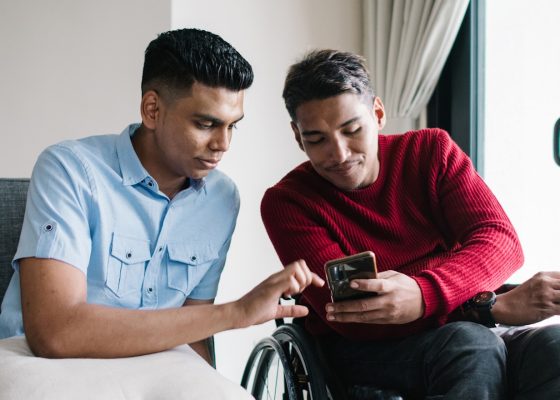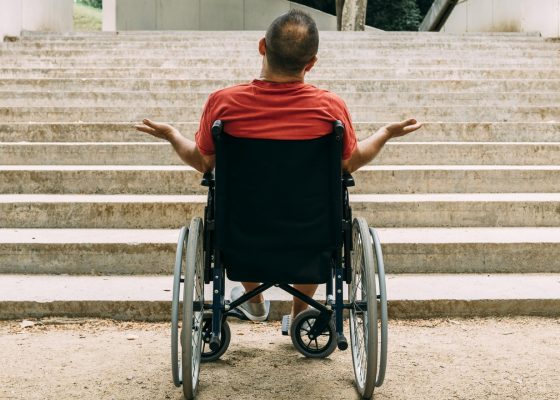Kids on the NDIS should be included in Thriving Kids community-based supports, inquiry hears.
Thriving Kids could be a program that creates more inclusion for children with disabilities, said advocates at a federal inquiry hearing held in Sydney, and some of it might entail going back to the future.
The NDIS has worked for many, but not all children, the Standing Committee on Health, Disability and Ageing committee heard. Disability advocates painted a picture of gaps in the interface between multiple systems and organisations, a lack of awareness about what services were available and what best practice looked like, and inconsistencies in what was available around the country.
But there was optimism for what the new system could bring to children living with disabilities.
“The focus of Thriving Kids … seems to be at the heart … getting back to a focus on community engagement as well. And that’s something we can get behind, obviously, at a general level,” said Julian Laurens, senior policy officer at People With Disability Australia.
Darryl Steff, CEO of Down Syndrome Australia, agreed:
“Being able to stay on Thriving Kids is going to be a good thing – you don’t have to get off it just because you go on the NDIS, for example. I think there’s a lot of benefit there.
“If a lot of these supports through Thriving Kids end up being delivered as community-based and even group-based supports, the benefit and the importance of those family and peer connections should [also] be available for people who have an NDIS plan,” he said.
“There is a great opportunity here to have some community-based support that cuts across different support systems, some of which have existed in the past, and it’s an opportunity to go back to them, [and] to build on them and have something that actually leads to a more genuinely inclusive approach for people either currently on the NDIS, or in the future.”
According to the NDIA, there are now 294,960 NDIS participants with autism – 75% aged 18 or younger and 18% under the age of nine.
Around half of new entrants to NDIS are younger than nine years old, and 94% of them have a diagnosis of developmental delay or autism.
“The system works for some children and families, but it’s definitely not working for all children and families. And it really does come back to the families that are getting a best practice service and the families that aren’t, and that’s where some of the challenges lie at the moment,” said Ms Stacey Touma, co-chair of the Child and Family Disability Alliance and CEO of Alongside Families.
Codesign isn’t difficult
Involving people with disability from the start of the Thriving Kids design process is going to make it much easier to implement it at the end, said Mr Laurens.
“It shouldn’t be difficult. In fact I’d say it’s not difficult it all.”
A good example was the National Best Practice Framework for Early Childhood Intervention, he said.
“They’ve made an effort within that framework to reference rights, to reference disability and reference inclusion. And that wasn’t done in a haphazard way. It was done in a very structured way, with some consultation with somebody obviously understanding what the CRPD is, for example.”
Representation of people with disability on the inquiry and in the working group was “a good thing”, said Mr Laurens.
“You need to listen to that working group that’s going on now. I go back to that national best practice framework. They’ve gone out of their way to go and consult with these organisations. And you can see clearly in the final document where the voices are.
“And that’s what we want to see in Thriving kids. We want to see, when you work out what is going on with it, where the voice of disability is in that, where is all this lived experience that has been shared by the community, where is that reflected in the final product.”
What does best practice look like?
Many families don’t know, said Ms Touma.
“Group-based program can be so beneficial for children and families, but families are often seeing these as second best to one-on-one.
“Many families years ago participated in programs like Hanen, an evidence based program – for three months you’re coached, with a speech pathologist, with other families. That is building your capacity, providing lifelong strategies around communication.
“It’s really being able to help inform families that these [programs] are valuable,” she said.
The availability of programs and services varied across states and territories and the way they were implemented varied within jurisdictions too, the committee heard.
Some schools had modified timetables for children with disabilities, where children attended for two or three hours a day.
“And that’s in place for a long time. For us, that is a really concerning trend,” said Ms Karen Dimmock, CEO of the Association for Children with Disability.
“This comes up a lot with families. Now there’s been a real shift where schools aren’t allowing any allied health into school. They’ve got so many therapists coming in, class withdrawals. We’re hearing of some schools charging for space,” said Ms Touma.
“This isn’t best practice. Where we’ve seen it work really well is when it is in alignment with best practice, where it is coaching the teacher, sharing strategies, and it is, again, being able to help families understand what good quality looks like. Schools are more open when that type of approach is in place.”
Given the timeframe for rolling out Thriving Kids and previously existing community organisations and successful programs, there was no need to start from scratch, the committee was told.
“We’d be keen to see Thriving Kids implemented in tandem with general foundation supports … delivered by trusted local organisations who have those connections with their communities,” said Mr Steff.
Fixing access
Wait times for services are a well-known problem for NDIS participants, and the NDIA told the committee that fast access to early support, close to where participants live, is “one of the issues that Thriving Kids is seeking to address”.
“It’s one of the foundations of Thriving Kids,” said Amity Durham, deputy CEO of the NDIA branches Children, Specialised Services and Scheme Interfaces Children, and Specialised Services and Scheme Interfaces.
The NDIA anticipated three streams of access to services for children with autism and developmental delays depending on their needs – via the Thriving Kids program, straight to the NDIS program, or transitioning from Thriving Kids to the NDIS when they aged out of the former if need be.
“Thriving Kids is the starting point for many children who may not have really profound needs, but we do need to make sure that we have a really clear pathway for [when] higher support needs are identified in that Thriving Kids stage … to further support,” said Ms Touma.
There needed to be no-cost checks at various points to see if the child’s support needs had changed, added Ms Dimmock.
“Children are unpredictable, and a child here at 18 months and then where they are at two or three, it may not be immediately clear what their lifelong support needs are going to be.”
For others, such as those with chromosomal variations and those with intellectual disability, the pathway from Thriving Kids to the NDIS was particularly important.
“There are many children who would have a mild to moderate delay in this group, but they will live with more complex needs over time … and could well need a very agile pathway into the NDIS,” said Professor Jenny Downs from the National Centre of Excellence in Intellectual Disability Health.
Ms Amity said access to Thriving Kids, which would be developed alongside the program, was expected to be “clear [and we will] have the right tools in place to assess level of need and provide that early access”.
Meanwhile, the NDIA was also working on reviewing and improving access pathways to the NDIS for children and adults, to address issues arising through the NDIS review about consistency, transparency in decision making and access to support.
“We are taking a close look at how we assess access. We will be reviewing all of the tools [for assessing children]… and making sure that we have clear and consistent ways of assessing functional impairment in a way that would meet the criteria for the legislation,” said Ms Durham.
In order for children to access early interventions there needed to be a “web of checkpoints” within the community, the committee heard.
“It is really important that that developmental delay can be picked up at a whole range of points, including responding to when the families themselves have concerns, that they can go and access a check from maternal child health or GP,” said Ms Dimmock.
A lead practitioner could coordinate all of these checkpoints, and the NDIA noted that such a role was being actively considered for the NDIS in response to review recommendations.
Early learning services were a vital part of this web, inquiry participants said. But early educators did not necessarily know what the next steps were.
“It’s a complex system for even us to be able to understand and navigate and keep across the changes. So it really is important that we build capability of the early education sector to understand how they can support families in that pathway, because they’re really critical in a family’s journey,” said Ms Touma.
Using the nursing workforce would also greatly open up equitable access to support, said Ms Lyons.
“People who could afford to pay privately for specialists would get a diagnosis and had access to services. But we’ve got a whole population of children whose parents can’t afford that access, and then who sit on a waiting list.
“But with Thriving Kids, I think we’re looking at two really different levels – a kind of general need for support and navigation to the services that exist, and hopefully there’ll be more of them with this program, and the specialist level, which are really two different cohorts on a continuum of children.”
Medicare provisions allowing nurses to refer people to specialists and allied health services would also improve access, said Ms Lyons.
Maternal child and family health nurses were employed by the local health district, so some were able to refer within organisations, and some weren’t. But they couldn’t refer to a paediatrician. Nurses in general practice had to refer privately to allied health, with no Medicare provision such as the one under the chronic condition management plan for GPs, she said.
Professor Downs said that Thriving Kids was an opportunity to be “transdiagnostic”.
“It comes down to functioning, a meshing of medical and social models – we so desperately need to do that for disability – the collaborations, the potential to be inclusive and being strengths based,” she said.
Some medical professionals not trained enough, others under-utilised
Early identification is made more difficult by lack of training for medical professionals, said Mr Christopher Ouizeman, of the ADHD Foundation.
“If you have a look at the university curricula for psychologists and psychiatrists, the content that’s dedicated towards neurodiversity, ADHD in particular, is very, very minor. We’ve already got a lack of psychologists and psychiatrists in the community, and even fewer of those specialise in this area,” said Mr Ouizeman.
Because supply outstripped demand, GPs had been brought into the equation, but they needed specialist training, said Mr Ouizeman.
“The issue with that is, as a general practitioner, by nature, they’re general and they need to undertake a specific area of specialism in order to be able to identify what is a very, very complicated condition. Neurodiversity, ADHD, autism – they manifest in different ways, and it’s very difficult to pinpoint this.”
Training needed to be mandatory, said Mr Ouizeman.
“It seems to us that the government has underestimated the impact of neurodiversity, particularly ADHD. And you know, it should be a condition that is held with equal importance as other chronic conditions from a training and development perspective.”
The committee’s chair, GP Dr Michael Freelander MP, was concerned about children being labelled early.
“Clearly, we don’t want to over-medicalise child behaviour at a very young age. How can we make parents aware of what is normal childhood behaviour?” he asked representatives from ADHD Australia and the ADHD Foundation.
“What is the normal spectrum of childhood behaviour, as well as development? Because we don’t seem to be doing a very good job in many communities at the moment.”
Mr Ouzieman responded that the assessments for ADHD were in-depth.
“It’s not about filling out a form, answering a few questions and then getting a diagnosis with children. It needs to be done at a longitudinal level. There needs to be 360-degree assessment and so forth.
“It’s a serious issue. ADHD is actually a bona fide medical condition, which depending upon how extreme it is will, in most cases, require medication. So, no different to diabetes where, you know, depending upon how severe your diabetes, you will need insulin,” he said.
There was no “magic bullet” for early diagnosis by parents, but they should take concerns to a properly trained healthcare professional, he said.
“For severe cases, what’s outside of, quote unquote, ‘normal’ becomes quite clear,” added Matt Tice, chair of ADHD Australia.
“But I think the point is that often the first point of contact is not the general practitioner. It’s more likely to be the parent, and it’s more likely to be early childhood learning, or someone else in the community that’s familiar with ADHD or autism.”
These community-based professionals, like early childhood educators, schools, out-of-home-care and others, needed to recognise when a child was having difficulties and required training to see those early signs, said Ms Kelly Dargan, from ADHD Australia.
It was unlikely that a child would be diagnosed with ADHD prior to age five or six, said Mr Tice.
“But being able to understand which pathways are available to you at an earlier age is really important … because treatment can happen before diagnosis and resources can be shared before diagnosis, and certainly intervention can happen at an earlier stage, which will be beneficial no matter what, regardless of later diagnostics,” said Mr Tice.
Denise Lyons, a nurse practitioner in general practice, said nurses were often the first people parents voiced their concerns to, but there was a lack of consistency around how developmental concerns were identified and managed that resulted in a “postcode lottery”.
“Empowering primary health care nurses is essential to making the promise of the thriving Kids initiative a reality,” she said.
The Australian Primary Health Care Nurses Association and the Maternal, Child Family Health Nurses of Australia supported the use of a standardised national screening tool at 18 months, and creating Medicare items to fund early assessment and referral by nurse practitioners and appropriately qualified registered nurses.
“Primary health care nurses are ready, willing and able to hold them more responsibility in this area,” said Ms Lyons.
“We’ve got this massive workforce that is either trained or trainable in specific tools that we already have in Australia,” said Ms Jan Finlayson, a director of Maternal, Child and Family Health Nurses Australia.
“The evidence says that if we’re screening using tools that have been recommended under the framework, then paediatricians don’t need to do the screening and can go straight to diagnosis.
“As a qualified maternal child health nurse with four qualifications sitting behind me, I have to say to the mum, now you need to go back to your general practitioner and get [them] to refer you to the paediatrician. That depends on the general practitioner actually believing the score,” said Ms Finlayson.
“And the evidence tells us that a skilled practitioner, I’m not just talking about maternal and child health nurses, I’m also talking about GPS and [paediatricians], can pick up a neurodiversity in children at eight months.
“Most of us in my profession will catch them at 12, but we say that 18 is a good yardstick, because you’ve got different levels of expertise.”
Related
First Nations people
There are 60,529 First Nations participants (8% of all participants), half of them children (30% under the age of nine and 20% are aged 9-14). Thirty-five percent of First Nations NDIS participants of all ages have an autism diagnosis.
Janine Mohamed, deputy CEO of the First Nations branch of the NDIA, told the hearing that those numbers are likely an underestimate, as people often did not feel safe identifying.
“The system is complex. It’s not culturally safe, according to their experience of the scheme. There’s issues in terms of identification, particularly where kinship arrangements are in place,” said Dr Mohamed.
“The historical experience of First Nations people, not just with the agency … leads First Nations people to be apprehensive, particularly where children are concerned, due to child removal.”
Cultural safety was being built into the NDIS plans of First Nations people, including children, she said.
“Our Safeguards and Quality Commission at the moment are looking at their standards, so we’re hoping to work with them to embed cultural safety as a standard.
“The other issue is that in remote communities, standards can be prohibitive as well, in that communities aren’t necessarily funded and set up to respond to all of the standards. So we’ll be working with the … commission on how we might be able to tailor that and balance integrity and risk and quality with access and equity in First Nations communities.”
Another way the agency was building trust was to increase the Aboriginal and Torres Strait Islander health and disability workforce with remote community connectors and Aboriginal disability liaison officers who are placed in Aboriginal community-controlled health services, as well as embedding an Aboriginal health workforce into access and assessment models.
“I do understand, through our conversations with NACCHO, that the numbers are growing. There is growth that’s been expected within [the National Indigenous Australians Agency] and the remote community workforce as well,” Dr Mohamed said.
Furthermore, even when NDIS plans were in place, they were underutilised, the committee heard. This was largely due to providers and “thin markets”, said Dr Mohamed.
Out of 50,000 NDIS providers, fewer than 1% are First Nations providers, but the agency was working on increasing that number. They have a market development discussion paper due in the next couple of weeks, they’re looking at partnering with ACCHOs, and they are planning to create a market sector development roadmap with communities to grow those markets.
The Thriving Kids program is expected to commence on 1 July 2026. The federal government committed $2 billion, to be matched by states and territories. However, it is not yet clear what services will be paid for as part of the program, and who will pay for them.
Parents need formalised help, and a lot of it
It takes around six years for families to connect with others after a diagnosis and all of them wish they could have done so earlier, the committee heard, and families wanted it to happen much sooner.
They highlighted programs like MyTime, a national peer support group with both place based and virtual options, playgroups, especially culturally specific ones, said Ms Dimmock. Her organisation also runs First Steps, which helps families navigate everything from how to get keys to disabled toilets to when to use your carer card.
“One thing that previously ran and doesn’t anymore was Early Days. That was a program led by some of the autistic organisations, helping families understand autism. And families really felt that by parents or grandparents being able to come along right from the start and as a family have a sense of, okay, this is what having an autistic child means, and how do we all work together to support them, how helpful that was, and that’s definitely missed at the moment,” said Ms Dimmock.
Referrals to peer support services needed to happen at the same time as referrals to clinical services, said Ms Touma. A good example was at Perth Children’s Hospital, where families receiving a diagnosis at the genetics clinic were taken to their family support worker and connected with Kiind, a peer support organisation for families raising children living with disability, developmental delay, autism, genetic, rare, undiagnosed and/or chronic conditions, at that point.
“We need to have models of support like that, and establish referral pathways. And we do have those very ad hoc. We work a lot with health, a lot with genetics and other teams, but they need to be more formalised,” said Ms Touma.
Melissa Webster from ADHD Australia also pointed out that sometimes parents had their own ADHD or autism diagnoses, and support for them needed to take this into account.
93% of providers are unregistered
At Monday’s hearing, the committee heard from the NDIS Quality and Safeguards Commission that only 7% of NDIS providers are registered with the commission, a number that was still a matter of discussion today.
Aged care has a mandatory registration system, whereas with NDIS providers only some in specialist services had to be registered. But there are far fewer providers in aged care, the commission said.
What the commission really wanted was to be able to see who all of the providers were and the level of risk associated with the service they were providing, and with that information to set quality standards.
The NDIA clarified yesterday that some providers, such as allied health practitioners, were still regulated under their own professional associations. And the commission had the powers to investigate and take action against providers for poor practice whether they were registered or not.
“We do have a large and a growing team of people investigators that are pursuing cases of fraud and poor practice by providers, and so we are able to then look at the broader data around that provider, different claims, look for poor practice, and then, in conjunction with the commission, take action against those providers.
The commission said 41% of complaints received by the commission were in relation to “sharp practices”, such as overcharging for example, which might be lawful but were “ethically dubious” or “not ridgey-didge”.
“We are significantly increasing our activity in terms of that fraudulent and sharp practice,” said the NDIA’s Ms Durham yesterday.




